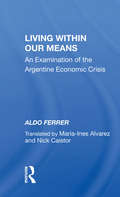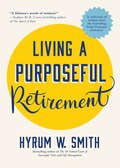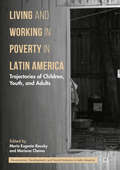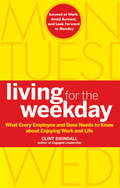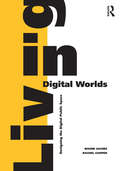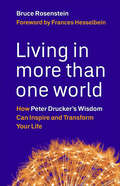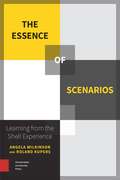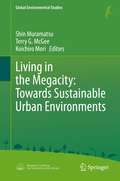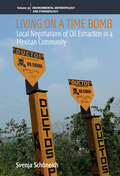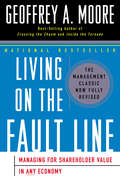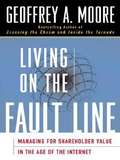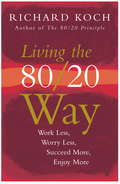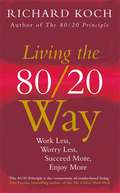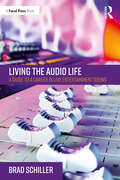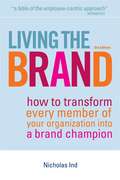- Table View
- List View
Living Within Our Means: An Examination Of The Argentine Economic Crisis
by Aldo FerrerThis book originally published in 1985, looked at Argentina's international insolvency issues and looks at the dilemma of how to proceed in order to ensure its economic sovereignty; in other words, its right to its own destiny. The book goes beyond social and economic areas and concludes that for real independence the Argentine Government has to ta
Living Your Best Life After 50 All-in-One For Dummies
by The Experts at AARP The Experts at For DummiesGet inspired — and prepared — for your best life at 50+ Living Your Best Life after 50 All-in-One For Dummies is your guide as you explore new opportunities and make the most of your fifties and the decades that follow. Find a new job, travel for weeks or months at a time, boost your health with yoga routines, take up pickleball—whatever it is you want to do, this book will inspire you to improve your life and show you how to get there. You’ll also find timely information about planning and budgeting for retirement, withdrawing money from IRAs and 401(k)s, and taking Social Security. With this fun- and information-packed Dummies resource, you can look forward to your future with enthusiasm and purpose. Change jobs, move up in your career, or get ready for retirement Get tips for travel, living like a nomad, cooking after the kids leave home, downsizing, and other handy topics for this time of your life Stay in tip-top shape with fun activities like yoga and pickleball Get your finances in order and make sure you can live the life you want on Social Security and retirement income This book is a great choice for readers looking to make the second half of life the best half.
Living a Purposeful Retirement
by Hyrum W. SmithYour Personal Roadmap to a Meaningful and Happy RetirementSo you’ve reached your retirement age and are at risk of becoming a “couch potato”. It doesn’t have to be that way. Uncover the joy of retirement and learn how to make the most of it with this life-enhancing retirement gift book.Did you just set up a permanent out of office reply? Are you officially signed up for the Ferris Bueller phase of your life? Learn how to enter what can be the most satisfying life stage —a new world of happy retirement and good living.Wisdom and advice from real retirees. From the award-winning author of Purposeful Retirement and celebrated “Father of Time Management,” Hyrum Smith, this retirement gift book for the newly retired provides inspiration and a newfound purpose. Filled with wisdom, advice from real retirees, and enthusiasm, you are encouraged to discover your true passion, re-imagine your life, and try new possibilities.Realize the hidden magic of a happy retirement:Move on from your world of workDiscover your true passionsRe-imagine your lifeRetirement is a gift. Make yours one that is meaningful and filled with curiosity, new experiences, and discovery —after all, if you don’t look around once in a while, you could miss it!If you enjoyed life-changing books such as The Total Money Makeover, The Ultimate Retirement Guide for 50+, or Keys to a Successful Retirement, then you’ll love Living a Purposeful Retirement.
Living and Working in Poverty in Latin America: Trajectories of Children, Youth, and Adults (Governance, Development, and Social Inclusion in Latin America)
by María Eugenia Rausky Mariana ChavesThis edited volume studies the complex interrelation of poverty, work, and different stages in the life course, and how it contributes to the permanent existence of poverty and inequality in vulnerable groups in society. Mechanisms of productions and reproduction of these relationships are identified through empirical research carried out in four Latin American countries: Mexico, Argentina, Brazil, and Cuba. This book centers on the experiences of individuals in those less favored social groups who may have suffered structural poverty for decades, or who may have been simply deprived of a basic income to cover their most essential needs.
Living at the Border: Life After Psychological Impasse
by Timothy ButlerEveryone will eventually face an impasse crisis, whether it lasts a day or a number of years, but only you can decide what you take from the experience. Impasse invites you to shed your fears and see what is actually presenting itself to you, right now. This chapter discusses the benefits of allowing yourself to truly go through psychological impasse.
Living for the Weekday
by Clint SwindallPraise for Living for the Weekday "If you want to have a team where leaders and employees are working hand-in-hand to build a culture of employee engagement, then you need to read this book. I'm confident it will help you become a weekday warrior. " -Jon Gordon bestselling author of The Energy Bus and Soup "In Living for the Weekday, Clint Swindall has rounded out a powerful message. Each individual has a personal responsibility, a singular opportunity to be highly engaged as an employee and, more importantly, highly productive and happy in all aspects of life. "-Barry Malcolm, Managing Director, Scotiabank Bahamas Ltd. "If you want to unlock your potential and the potential of those around you, Living for the Weekday is a must read. " -Mike Crownover, Senior Vice President, Human Resources, Valero Energy Corporation "Employee engagement is a two-way street with both employers and employees responsible for creating a positive and productive work environment. . . Living for the Weekday presents employees with a practical and powerful approach to taking control of their own happiness. "-Roger C. Ahlfeld Senior Vice President, Human Resources and Training, Uno Chicago Grill "Clint Swindall lays out a clear plan that anyone can apply to become more engaged in their work and in their lives. " -Dennis Snow, author of Unleashing Excellence
Living in Digital Worlds: Designing the Digital Public Space
by Rachel Cooper Naomi JacobsLiving in Digital Worlds investigates the relationship between human society and technology, as our private and particularly our public lives are increasingly undertaken in spaces that are inherently digital: digital public spaces. The book unpicks why digital technology is such an inextricable part of modern society, first by examining the historical relationship between technological development and the early progression of human sociality. This is then followed by an examination of the ways in which modern life is currently being impacted by the expansion of digital information and devices into multiple aspects of our lives, including focuses on privacy, bias and ownership in digital spaces. Finally, it explores potential future developments and their implications, and proposes that it is crucial to consider the design of technology and systems in order to support a positive and beneficial direction of change. Each chapter includes case studies, primarily drawn from The Creative Exchange, a fiveyear programme which ran from 2012 to 2016 to explore the notion of the digital public space through collaborative cross-sector research.
Living in More Than One World: How Peter Drucker's Wisdom Can Inspire and Transform Your Life
by Bruce RosensteinMillions revere Drucker as “the father of modern management”—this is the first book to share his reflections on self-management • Based on Bruce Rosenstein’s 20 years-plus study of Drucker’s life and thought • Helps you construct a complete life plan through exercises, questions, and illustrative anecdotes and quotes How can we have a rich and fulfilling life? For Peter Drucker, one of the most influential thinkers of modern times, the secret was “living in more than one world”—enjoying a diverse set of interests, activities, acquaintances, and pursuits. Drucker was able to do this despite extraordinary demands on his time, and now Bruce Rosenstein shows how the man who transformed organizational management can transform the way you manage your personal and professional life. An enormously influential business author and consultant, Drucker also wrote extensively on self-development and self-management, but these writings are scattered throughout dozens of books and articles. For the first time Rosenstein brings these ideas together into a straightforward framework that guides you in building a multifaceted life and career. It’s the next best thing to being mentored by Drucker himself. Rosenstein shares Drucker’s advice for, first, honing in on your core competencies—developing your main talents, clarifying your values, and managing your time. With this firm foundation established he uses Drucker as both source and example to show how to enrich your life by developing parallel and second careers, making a difference in the lives of others through voluntarism and service, and using teaching and lifelong learning as complimentary ways of staying engaged and up to date. By living in more than one world you gain new insights, see your world from fresh perspectives, access ever-changing sources of inspiration and stimulation. Peter Drucker managed a varied professional life as a writer, educator, and consultant, and was deeply immersed in literature, music, and art. But he wasn’t superhuman. This is a life that can be lived by anybody who has the tools and Bruce Rosenstein provides them in this thoughtful and inspiring book.
Living in a Lattice World: The Challenges of Evolving the Workplace to Match the Changing Workforce
by Cathleen Benko Anne WeisbergChanges in the demographics of the workforce, the shift toward a knowledge-driven economy, the structure of family life, the evolution of enabling technology, and the nature of work itself are challenging the firmly rooted corporate-ladder model of career progression. A new latticelike model is emerging in its place, opening alternative paths for high-performing, high-potential employees to not only contribute to achieving strategic priorities in the short term but to remain connected to the organization in ways that allow for greater contributions over the long term. This chapter summarizes four major workforce challenges facing organizations today and describes how mass career customization (MCC)-the framework behind the lattice structure-will help business leaders address each in the coming years. This chapter is excerpted from "Mass Career Customization: Aligning the Workplace with Today's Nontraditional Workforce."
Living in the Environment (17th Edition)
by G. Tyler Miller Scott E. SpoolmanThis book provides you with basic scientific tools for understanding and thinking critically about the environment and the environmental problems we face.
Living in the Environment: Principles, Connections, and Solutions
by G. Tyler Miller Scott E. Spoolman Jr.Learn how to make a difference in our environment! Using sustainability as the central theme, this current and thought-provoking book provides you with basic scientific tools for understanding and thinking critically about the environment and the environmental problems we face. Updated with new information, art, and "Good News" examples, this engaging book offers vivid case studies and hands-on quantitative exercises. The concept-centered approach transforms complex environmental topics and issues into key
Living in the Megacity: Towards Sustainable Urban Environments (Global Environmental Studies)
by Shin Muramatsu Terry G. McGee Koichiro MoriThis book tackles the challenging issues raised by the growth of large megacities from diverse perspectives and approaches. The central question raised by the growth of megacities is what effect their growth will have on the ability of the global population to live in sustainable, livable, and safe societies. In Part I, important issues on the relationships between megacities and sustainability of the global environment are specified. Part II shows what can be learned from the history and diversity of megacities to solve challenging issues of the present. We present practical approaches that can solve the issues of megacities particularly focusing on human activities that seek the more harmonious relationship between life amenities and the natural environment: population density and urban built environment; production and trade; and environmental education and enlightenment. Part III aims to answer the question, what aspects of megacities should be measured and assessed? Barometers are necessary to control human activities in megacities. We consider how to measure and assess performances of megacities, reviewing some cases of indicators that authors have developed. This publication highlights the challenging issues of the relationships between megacities and sustainability of the global environment and related issues that have accrued from them, based on the following three scales: long-term time scale from the past to the present and future; a vast spatial scale that links global space with local spaces; and the scale of various aspects of human socio-economic activities in megacities.
Living on Internet Time: Product Development at Netscape, Yahoo!, NetDynamics, and Microsoft
by Marco Iansiti Alan MaccormackDescribes how four companies in the Internet software market approach product development. Drawing upon short case studies of three recent projects, students are invited to synthesize the common attributes of development practice in turbulent environments.
Living on a Budget/ Road Trip (Lifeskills in Action)
by Jane Gardner Pj GrayThemes: LifeSkills, Budgeting, Money Skills, Independent Living, Flip Book, Fiction, Nonfiction, Teen, Young Adult, Emergent Reader, Hi-Lo, Hi-Lo Books, Hi-Lo Solutions, High-Low Books, Hi-Low Books, ELL, EL, ESL, Struggling Learner, Struggling Reader, Special Education, SPED, Newcomers, Reading, Learning, Education, Educational, Educational Books. Each 5-book set in the series covers a key aspect of independent living, such as managing money, finding and keeping a job, or completing common household tasks. Developed for students reading at the most basic level, the books range in readability from 1.3–1.8 and have Lexile scores of 130L to 240L. Each book is actually two books in one, with a nonfiction side and a fiction side. The nonfiction side teaches students about an important life skills topic, and the fiction side helps them generalize the skills as they read about teens in real-world situations. Build students’ personal finance skills with this five-book set. Important aspects of managing money are explored in these nonfiction/fiction flip books. Topics include: budgeting, opening a bank account, credit, coupons, and saving.
Living on a Time Bomb: Local Negotiations of Oil Extraction in a Mexican Community (Environmental Anthropology and Ethnobiology #30)
by Svenja SchöneichProviding a holistic understanding of extensive oil extraction in rural Mexico, this book focuses on a campesino community, where oil extraction is deeply inscribed into the daily lives of the community members. The book shows how oil shapes the space where it is extracted in every aspect and produces multiple uncertainties. The community members express these uncertainties using the metaphor of the time bomb. The book shows how they find ways to "live off the time bomb" by using mechanisms of short-term coping and long-term adaptation and thus, developing the capability to determine their lives despite the ever-changing challenges.
Living on the Fault Line
by Geoffrey A. MooreThe fault line -- that dangerous, unstable seam in the economy where powerful innovations and savage competition meet and create market-shattering tremors. Every company lives on it; no manager can control it. In the original edition of Living on the Fault Line, Geoffrey Moore presented a compelling argument for using shareholder value (or share price) as the key driver in management decisions. Moore now revisits his argument in the post-Internet bubble world, proving that the methods he espouses are more germane than ever and showing companies how to use them to survive and thrive in today's demanding economy. Extending the themes of Crossing the Chasm and Inside the Tornado, his first two books on the dynamics of the high-tech markets, Moore shows why sensitivity to stock price is the single most important lever for managing in the future, both as a leading indicator of shifts in competitive advantage and as an employee motivator for making necessary changes in organizations heretofore impervious to change. This revised and updated edition includes: A deeper emphasis on core versus context, which has emerged as the key distinction in allocating resources to improve shareholder value A new Competitive Advantage Grid that will aid managers in achieving and sustaining competitive advantage, the most important component in managing for shareholder value An expanded Value Discipline Model as it relates to the Competitive Advantage Grid Analysis of the powerful new trend toward core/context analysis and outsourcing production duties Updated models of organizational change for each stage of market developmentAs disruptive forces continue to buffet the marketplace and rattle the staid practices of the past, Moore offers a brilliant set of navigational tools to help meet today's most compelling management challenges.
Living on the Fault Line,ition
by Geoffrey A. MooreThe fault line -- that dangerous, unstable seam in the economy where powerful innovations and savage competition meet and create market-shattering tremors. Every company lives on it; no manager can control it. In the original edition of Living on the Fault Line, Geoffrey Moore presented a compelling argument for using shareholder value (or share price) as the key driver in management decisions. Moore now revisits his argument in the post-Internet bubble world, proving that the methods he espouses are more germane than ever and showing companies how to use them to survive and thrive in today's demanding economy. Extending the themes of Crossing the Chasm and Inside the Tornado, his first two books on the dynamics of the high-tech markets, Moore shows why sensitivity to stock price is the single most important lever for managing in the future, both as a leading indicator of shifts in competitive advantage and as an employee motivator for making necessary changes in organizations heretofore impervious to change. This revised and updated edition includes: A deeper emphasis on core versus context, which has emerged as the key distinction in allocating resources to improve shareholder value A new Competitive Advantage Grid that will aid managers in achieving and sustaining competitive advantage, the most important component in managing for shareholder value An expanded Value Discipline Model as it relates to the Competitive Advantage Grid Analysis of the powerful new trend toward core/context analysis and outsourcing production duties Updated models of organizational change for each stage of market developmentAs disruptive forces continue to buffet the marketplace and rattle the staid practices of the past, Moore offers a brilliant set of navigational tools to help meet today's most compelling management challenges.
Living on the Fault Line: Managing for Shareholder Value in Any Economy
by Geoffrey A. MooreBusiness advice that focuses on stock price as an important lever for management. Tips on how to thrive in a demanding economy.
Living the 80/20 Way, New Edition
by Richard Koch"The 80/20 principle is the cornerstone of results-based living. Read this book and use it."-Timothy Ferriss, New York Times best-selling author of The 4-Hour WorkweekAcclaimed entrepreneur and author Richard Koch changed the face of the business world with The 80/20 Principle. In Living the 80/20 Way, a self-help bestseller, he returns to show how working and worrying less can transform our personal lives. Koch takes the widely renowned 80/20 principle and shows how in today's cluttered and stressful world, working out the few things that are really important, and the few methods that will give us those things, leads to increased happiness and greater success. Living the 80/20 Way explains why "less is more" isn't just a saying, but a sure-fire method to achieve your goals and live your best life.Richard Koch is a British author, speaker, and investor, and a former management consultant and entrepreneur. He has written over twenty books on business and ideas, including The 80/20 Principle, about how to apply the Pareto principle in management and life. Koch got an MBA from The Wharton School of the University of Pennsylvania and worked as a consultant at The Boston Consulting Group, and at Bain & Company from 1980 to 1983. In 1983 he co-founded The LEK Partnership, an international strategy consulting firm, with headquarters in London, England.
Living the 80/20 Way: Work Less, Worry Less, Succeed More, Enjoy More
by Richard KochAcclaimed entrepreneur and author Richard Koch changed the face of the business world with The 80/20 Principle. In Living the 80/20 Way, a self-help bestseller, he returns to show how working and worrying less can transform our personal lives. Koch takes the widely renowned 80/20 principle and shows how in today's cluttered and stressful world, working out the few things that are really important, and the few methods that will give us those things, leads to increased happiness and greater success. Living the 80/20 Way explains why 'less is more' isn't just a saying, but a sure-fire method to achieve your goals and live your best life.
Living the 80/20 Way: Work Less, Worry Less, Succeed More, Enjoy More - Use The 80/20 Principle to invest and save money, improve relationships and become happier
by Richard Koch'The 80/20 principle is the cornerstone of results-based living. Read this book and use it.' -Tim Ferriss, New York Times best-selling author of The 4-Hour WorkweekAcclaimed entrepreneur and author Richard Koch changed the face of the business world with The 80/20 Principle. In Living the 80/20 Way, he shows how working and worrying less can transform our personal lives. Koch takes the widely renowned 80/20 principle and shows how in today's cluttered and stressful world, working out the few things that are really important, and the few methods that will give us those things, leads to increased happiness and greater success. Living the 80/20 Way explains why 'less is more' isn't just a saying, but a sure-fire method to achieve your goals and live your best life.
Living the Audio Life: A Guide to a Career in Live Entertainment Sound
by Brad SchillerLiving the Audio Life details the aspects and procedures necessary for one to have a successful career in live entertainment sound. Encompassing a wide range of topics, the text clearly guides anyone interested in working in a position within the live entertainment audio field. The guide is broken into clearly defined sections, allowing the reader to easily navigate through various subjects including jobs, career, business, creativity, lifestyle, and travel. Real-world examples and documentation from the author and key industry experts allow the reader to gain insight into the essential practices that are helpful throughout a career. Additional in-depth interviews provide details of careers from industry veterans. Whether considering a career in live entertainment audio or just starting out, readers will find the resources for the key to success in audio. Students, those new to sound, and workers already within their careers can refer to the text as a guide throughout their journeys. With benefits to anyone interested in the audio field, Living the Audio Life is a key navigational resource for success.
Living the Brand: How to Transform Every Member of Your Organization into a Brand Champion
by Nicholas IndYour company's workforce is its most valuable asset. It is the employees who translate your organization's strategy into reality, interact with consumers and determine the corporate brand.Living the Brand demonstrates how you can empower and enthuse your employees to create "brand champions". This approach enhances employee commitment, improves service standards and focuses efforts to deliver business goals.This practical, inspirational book shows you that employees flourish in organizations where they identify with the brand, and organizations flourish when the brand has relevance and creates meaning.Using original international case studies, such as IBM, SAS Airlines, UNICEF, Apple and Nike, Living the Brand shows you how to make this happen, through research, training, communication, management and review. It examines the nature of branding and why people have become such important definers of their brand.Living the Brand is a CarbonNeutral® publication. To offset the carbon dioxide emissions generated in the book's production, native trees have been planted with Future Forests.
Living the Dream: Building a Sustainable Career in the Performing Arts
by Kirstin Chávez Johnathon PapeLiving the Dream: Building a Sustainable Career in the Performing Arts offers an accessible guide to understanding one’s arts career as a business. This essential companion to the inner workings of the arts world begins with defining the dream, including how to conceive mission statements, branding and business plans. Part II covers sharing the dream with others through social media, networking, and working with agents or artist managers. Part III offers an overview of the financial aspect, including budgets, taxes, and managing risks. Part IV concludes by discussing the realities of an arts career, including work/life balance, preparing for the future, and managing mental health. This practical and insightful overview is a must‑have companion for aspiring and early career professionals in the performing arts, as well as students on a range of arts courses, including Music Business, Entrepreneurship, and Career Skills classes.
